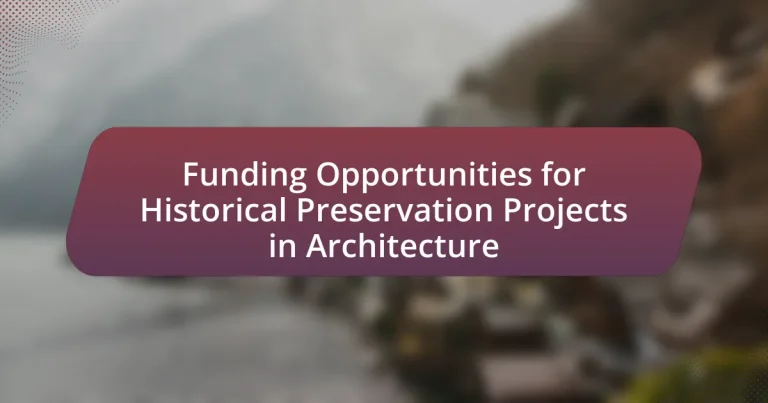Funding opportunities for historical preservation projects in architecture are essential for maintaining and restoring historically significant structures. This article outlines various funding sources, including federal grants from the National Park Service, state programs, and private foundations like the Getty Foundation and the National Trust for Historic Preservation. It details the types of projects eligible for funding, the criteria for qualification, and the importance of financial support in preserving cultural heritage. Additionally, the article discusses strategies for securing funding, the role of community engagement, and best practices for managing funded projects to ensure compliance and effective reporting on outcomes.

What are Funding Opportunities for Historical Preservation Projects in Architecture?
Funding opportunities for historical preservation projects in architecture include federal grants, state programs, and private foundations. The National Park Service administers the Historic Preservation Fund, which provides grants for preservation projects through state historic preservation offices. Additionally, the National Trust for Historic Preservation offers various funding programs, including the National Trust Preservation Fund, which supports preservation planning and education. State governments often have their own funding initiatives, such as tax credits and grants, to encourage local preservation efforts. Furthermore, private organizations like the Getty Foundation and the Kress Foundation provide grants specifically for architectural preservation projects. These funding sources are essential for maintaining and restoring historically significant structures.
How do these funding opportunities support architectural preservation?
Funding opportunities support architectural preservation by providing financial resources necessary for the restoration and maintenance of historic structures. These funds enable organizations and individuals to undertake projects that protect cultural heritage, ensuring that significant architectural sites are preserved for future generations. For instance, the National Park Service’s Historic Preservation Fund allocates millions annually to state and local governments, non-profits, and tribes, facilitating the rehabilitation of historic buildings and promoting community revitalization. This financial backing is crucial, as it often covers costs associated with research, planning, and construction, which can be prohibitively expensive without external support.
What types of projects are eligible for funding?
Eligible projects for funding in historical preservation include restoration, rehabilitation, and conservation of historic buildings and sites. These projects must demonstrate significance in architectural history, cultural heritage, or community value. For instance, the National Park Service provides grants for projects that preserve structures listed on the National Register of Historic Places, ensuring that they maintain their historical integrity while adapting to modern needs.
What criteria must be met to qualify for funding?
To qualify for funding for historical preservation projects in architecture, applicants must demonstrate that their project aligns with specific criteria set by funding organizations. These criteria typically include the project’s potential to preserve or restore historically significant structures, compliance with local, state, and federal preservation standards, and the ability to contribute to community development or tourism. Additionally, applicants often need to provide a detailed project plan, budget, and timeline, as well as evidence of community support or partnerships. These requirements ensure that funded projects effectively contribute to the preservation of architectural heritage and meet established guidelines for historical significance.
Why is funding important for historical preservation in architecture?
Funding is crucial for historical preservation in architecture because it provides the necessary financial resources to maintain, restore, and protect significant structures. Without adequate funding, many historical buildings face deterioration, neglect, or demolition, which can lead to the loss of cultural heritage. For instance, the National Trust for Historic Preservation reports that every dollar invested in preservation generates an average of $4 in economic returns, highlighting the financial viability of such projects. Additionally, funding enables the employment of skilled craftsmen and the use of appropriate materials, ensuring that restoration efforts adhere to historical accuracy and integrity.
What impact does funding have on community heritage?
Funding significantly enhances community heritage by providing the necessary financial resources for preservation, restoration, and promotion of historical sites and cultural practices. For instance, grants from organizations like the National Trust for Historic Preservation enable communities to maintain and restore landmarks, which fosters local identity and pride. Additionally, funding can support educational programs that raise awareness about heritage, ensuring that cultural traditions are passed down through generations. Research indicates that communities with robust funding for heritage projects experience increased tourism, which can further stimulate local economies and reinforce the importance of preserving cultural assets.
How does funding influence the sustainability of preservation efforts?
Funding directly influences the sustainability of preservation efforts by providing the necessary financial resources to maintain and restore historical sites. Adequate funding ensures that preservation projects can cover costs such as materials, labor, and ongoing maintenance, which are critical for the longevity of these efforts. For instance, a study by the National Trust for Historic Preservation found that every dollar invested in preservation generates an average of $4 in economic benefits, highlighting the importance of financial support in sustaining these initiatives. Without consistent funding, preservation efforts may falter, leading to deterioration and loss of cultural heritage.

What sources provide funding for historical preservation projects?
Funding for historical preservation projects primarily comes from government grants, private foundations, and nonprofit organizations. Government grants, such as those from the National Park Service’s Historic Preservation Fund, provide financial assistance for preservation efforts. Private foundations, like the Getty Foundation, offer grants specifically aimed at preserving cultural heritage. Nonprofit organizations, including the National Trust for Historic Preservation, also provide funding and resources to support preservation initiatives. These sources collectively contribute to the financial viability of historical preservation projects, ensuring that significant sites and structures are maintained for future generations.
What government programs are available for funding?
The government programs available for funding historical preservation projects in architecture include the Historic Preservation Fund (HPF), administered by the National Park Service, which provides grants to states and tribes for preservation activities. Additionally, the Federal Historic Tax Credit program offers a 20% tax credit for the rehabilitation of historic buildings, incentivizing private investment in preservation. The National Trust for Historic Preservation also offers various grant programs aimed at supporting preservation efforts across the United States. These programs are designed to promote the conservation of historic sites and structures, ensuring their protection and sustainability for future generations.
How do federal grants support preservation initiatives?
Federal grants support preservation initiatives by providing financial resources that enable the conservation and restoration of historical sites and structures. These grants, such as those administered by the National Park Service through the Historic Preservation Fund, allocate millions of dollars annually to state and local governments, non-profit organizations, and tribal entities specifically for preservation projects. For example, in 2021, the National Park Service awarded over $30 million in grants to support preservation efforts across the United States, demonstrating the federal commitment to safeguarding cultural heritage.
What state-level funding options exist for historical projects?
State-level funding options for historical projects include grants, tax credits, and matching funds provided by state historical societies or preservation offices. For example, many states offer specific grant programs aimed at preserving historical sites, such as the California Cultural and Historical Endowment, which allocates funds for projects that enhance the state’s cultural heritage. Additionally, tax credit programs, like the Massachusetts Historic Rehabilitation Tax Credit, incentivize property owners to restore and maintain historic buildings by offering significant tax reductions. These funding mechanisms are designed to support the preservation of historical architecture and ensure the maintenance of cultural heritage within the state.
What private organizations offer funding for architectural preservation?
Private organizations that offer funding for architectural preservation include the National Trust for Historic Preservation, which provides grants for preservation projects across the United States, and the Getty Foundation, known for its support of conservation initiatives globally. Additionally, the Kress Foundation offers funding specifically for the preservation of art and architecture, while the Landmarks Preservation Council of Illinois provides grants for local preservation efforts. These organizations have established programs and funding opportunities aimed at supporting the conservation of historically significant structures and sites.
How do foundations contribute to preservation funding?
Foundations contribute to preservation funding by providing grants and financial support specifically aimed at historical preservation projects. These foundations often focus on cultural heritage, environmental conservation, and community development, allocating millions of dollars annually to initiatives that protect and restore historical sites. For example, the National Trust for Historic Preservation, a prominent foundation, awarded over $4 million in grants in 2021 to various preservation projects across the United States, demonstrating their significant role in funding efforts that safeguard architectural heritage.
What role do non-profits play in funding historical projects?
Non-profits play a crucial role in funding historical projects by providing financial resources, grants, and expertise to preserve cultural heritage. These organizations often focus on specific historical sites or themes, mobilizing community support and donations to secure funding. For instance, the National Trust for Historic Preservation, a prominent non-profit, has awarded millions in grants to various preservation initiatives across the United States, demonstrating their impact on maintaining historical architecture. Additionally, non-profits often collaborate with government entities and private donors, amplifying funding opportunities and ensuring that significant historical projects receive the necessary financial backing for successful completion.

How can applicants effectively secure funding for their projects?
Applicants can effectively secure funding for their projects by thoroughly researching and identifying appropriate funding sources, crafting compelling proposals, and demonstrating the project’s potential impact. Researching funding sources includes exploring grants from government agencies, private foundations, and crowdfunding platforms specifically focused on historical preservation. Crafting a compelling proposal involves clearly articulating the project’s goals, significance, and budget, while also aligning with the funder’s priorities. Demonstrating potential impact can be achieved by providing data on community benefits, historical significance, and sustainability, which can enhance the proposal’s appeal. For instance, the National Trust for Historic Preservation offers grants that require applicants to show how their projects will contribute to community revitalization and heritage conservation, thus emphasizing the importance of aligning project objectives with funder interests.
What steps should be taken to prepare a funding application?
To prepare a funding application, one must follow a structured approach that includes several key steps. First, identify the funding source that aligns with the goals of the historical preservation project, ensuring it supports architecture-related initiatives. Next, gather all necessary documentation, including project descriptions, budgets, timelines, and any required permits or approvals.
Then, develop a compelling narrative that outlines the significance of the project, its impact on the community, and how it aligns with the funder’s objectives. This narrative should include specific details about the historical value of the architecture being preserved and any relevant statistics or case studies that demonstrate the project’s potential benefits.
After drafting the application, review it for clarity, coherence, and adherence to the funder’s guidelines, ensuring all required information is included. Finally, submit the application before the deadline, and be prepared to follow up with the funding organization for any additional information or clarification they may require.
How can applicants demonstrate the significance of their project?
Applicants can demonstrate the significance of their project by clearly articulating its historical, cultural, and architectural value. This can be achieved by providing detailed documentation that includes historical context, significance to the community, and potential impact on local heritage. For instance, referencing specific architectural styles or historical events associated with the project can substantiate its importance. Additionally, including testimonials from local historians or community leaders can further validate the project’s relevance and significance.
What common mistakes should be avoided in funding applications?
Common mistakes to avoid in funding applications include failing to follow guidelines, submitting incomplete information, and not clearly articulating project goals. Adhering to specific funding guidelines is crucial, as many applications are rejected for not meeting these requirements. Incomplete submissions can lead to disqualification, as funders often require detailed budgets and timelines. Additionally, a lack of clarity in project goals can confuse reviewers, making it difficult for them to understand the project’s significance and impact. These mistakes can significantly reduce the chances of securing funding for historical preservation projects in architecture.
What strategies can enhance the chances of obtaining funding?
To enhance the chances of obtaining funding for historical preservation projects in architecture, organizations should develop a comprehensive project proposal that clearly outlines objectives, budget, and expected outcomes. A well-structured proposal increases credibility and demonstrates the project’s alignment with funding priorities. Research indicates that projects with detailed plans and measurable goals are more likely to receive funding; for instance, the National Trust for Historic Preservation emphasizes the importance of clear project descriptions and community impact in their funding criteria. Additionally, building partnerships with local stakeholders and leveraging community support can significantly improve funding prospects, as collaborative efforts often resonate more with grantors.
How can collaboration with local communities improve funding prospects?
Collaboration with local communities can significantly improve funding prospects by enhancing project relevance and community support. When historical preservation projects actively involve local stakeholders, they align more closely with community values and needs, making them more attractive to potential funders. For instance, projects that demonstrate community engagement often receive higher priority in grant applications, as funding organizations prioritize initiatives that foster local involvement and benefit. According to a study by the National Trust for Historic Preservation, projects with strong community backing are 30% more likely to secure funding compared to those without such support. This evidence underscores the importance of collaboration in increasing the likelihood of financial backing for preservation efforts.
What role does public engagement play in securing funding?
Public engagement is crucial in securing funding for historical preservation projects in architecture as it demonstrates community support and interest, which funders prioritize. Engaging the public through outreach, workshops, and participatory planning fosters a sense of ownership and advocacy for preservation efforts. Research indicates that projects with strong public backing are more likely to receive financial support; for instance, the National Trust for Historic Preservation highlights that community involvement can enhance grant applications by showcasing local commitment and potential for broader impact. This alignment with funders’ goals of community benefit and sustainability reinforces the importance of public engagement in the funding process.
What are best practices for managing funded historical preservation projects?
Best practices for managing funded historical preservation projects include establishing clear project goals, engaging stakeholders, and maintaining thorough documentation. Clear project goals ensure that all team members understand the objectives and desired outcomes, which is crucial for effective project execution. Engaging stakeholders, including local communities and preservation experts, fosters collaboration and support, enhancing project sustainability. Thorough documentation of all processes, decisions, and expenditures not only aids in transparency but also provides a valuable resource for future projects and audits. These practices are supported by the National Park Service, which emphasizes the importance of stakeholder engagement and documentation in its guidelines for successful preservation projects.
How can project managers ensure compliance with funding requirements?
Project managers can ensure compliance with funding requirements by establishing a comprehensive compliance plan that outlines all necessary regulations and guidelines associated with the funding. This plan should include regular audits, documentation of all expenditures, and adherence to reporting deadlines. For instance, the National Park Service mandates specific reporting formats and timelines for federal funding, which project managers must follow to avoid penalties. Additionally, training team members on compliance protocols and maintaining open communication with funding agencies can further enhance adherence to requirements.
What methods can be used to report on project outcomes effectively?
Effective methods to report on project outcomes include the use of quantitative metrics, qualitative assessments, and visual presentations. Quantitative metrics, such as cost savings, time efficiency, and completion rates, provide clear, measurable data that stakeholders can easily understand. Qualitative assessments, including stakeholder interviews and case studies, offer insights into the project’s impact on the community and historical significance. Visual presentations, such as infographics and charts, enhance comprehension and engagement by illustrating key findings and trends. These methods collectively ensure that project outcomes are communicated clearly and effectively to all relevant parties.





